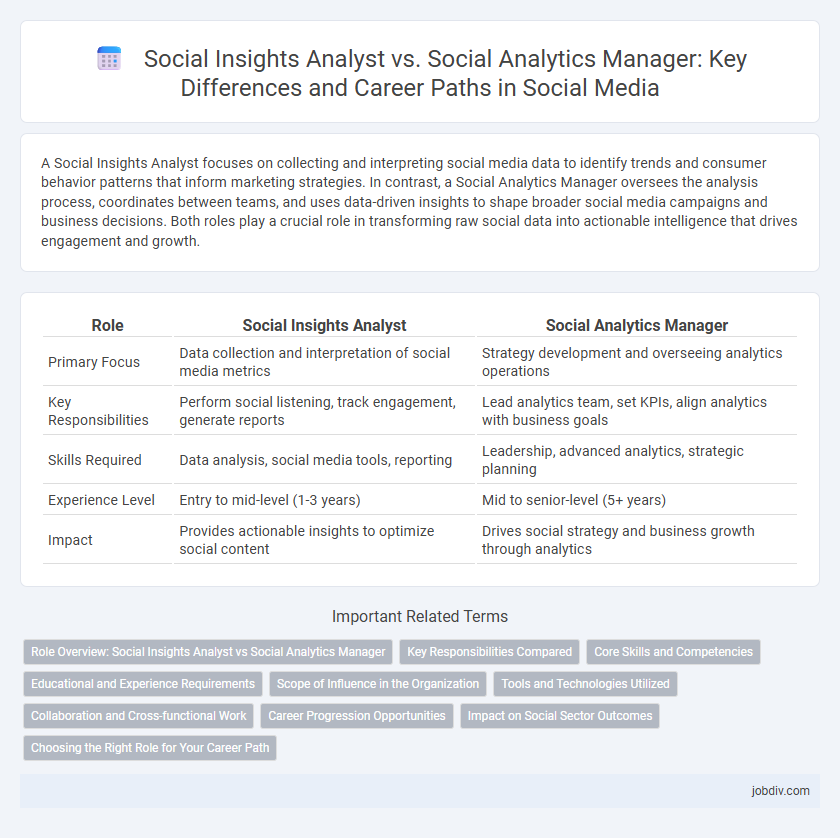A Social Insights Analyst focuses on collecting and interpreting social media data to identify trends and consumer behavior patterns that inform marketing strategies. In contrast, a Social Analytics Manager oversees the analysis process, coordinates between teams, and uses data-driven insights to shape broader social media campaigns and business decisions. Both roles play a crucial role in transforming raw social data into actionable intelligence that drives engagement and growth.
Table of Comparison
| Role | Social Insights Analyst | Social Analytics Manager |
|---|---|---|
| Primary Focus | Data collection and interpretation of social media metrics | Strategy development and overseeing analytics operations |
| Key Responsibilities | Perform social listening, track engagement, generate reports | Lead analytics team, set KPIs, align analytics with business goals |
| Skills Required | Data analysis, social media tools, reporting | Leadership, advanced analytics, strategic planning |
| Experience Level | Entry to mid-level (1-3 years) | Mid to senior-level (5+ years) |
| Impact | Provides actionable insights to optimize social content | Drives social strategy and business growth through analytics |
Role Overview: Social Insights Analyst vs Social Analytics Manager
A Social Insights Analyst specializes in collecting and interpreting social media data to identify trends, audience behavior, and campaign effectiveness, providing actionable insights for marketing strategies. In contrast, a Social Analytics Manager oversees the analysis team, develops data-driven strategies, and aligns social insights with overall business objectives to optimize social media performance. Both roles require proficiency in social listening tools, data visualization, and cross-functional collaboration but differ in leadership scope and strategic responsibility.
Key Responsibilities Compared
A Social Insights Analyst primarily focuses on collecting, analyzing, and interpreting social media data to identify trends, audience behavior, and campaign performance metrics. In contrast, a Social Analytics Manager oversees the analytics team, strategizing data-driven decisions, integrating insights into broader marketing strategies, and ensuring alignment with business goals. Both roles require expertise in social media metrics, but the manager emphasizes leadership and strategic application of social insights.
Core Skills and Competencies
A Social Insights Analyst excels in data interpretation, survey analysis, and trend identification, utilizing tools like Google Analytics and social listening platforms to generate actionable consumer insights. In contrast, a Social Analytics Manager combines advanced data skills with leadership abilities, overseeing analytics teams, developing strategic frameworks, and aligning social data insights with broader business objectives. Both roles require proficiency in quantitative analysis, strong communication skills, and a deep understanding of social media metrics, but the manager role demands enhanced project management and strategic planning competencies.
Educational and Experience Requirements
Social Insights Analysts typically require a bachelor's degree in marketing, communications, or data science with 1-3 years of experience in social media analytics and reporting. Social Analytics Managers often hold advanced degrees such as a master's in business analytics or marketing and possess 5-7 years of leadership experience managing social media strategies and analytics teams. Expertise in tools like Google Analytics, Tableau, and social media listening platforms is essential for both roles, with managers expected to have superior project management and strategic planning skills.
Scope of Influence in the Organization
A Social Insights Analyst primarily focuses on data collection, analysis, and reporting to provide actionable insights on social media performance and audience behavior. In contrast, a Social Analytics Manager oversees the entire analytics team, drives strategic decision-making, and influences cross-departmental initiatives by aligning social insights with broader business objectives. The manager's scope of influence extends beyond data analysis to shaping organizational strategies and stakeholder communication.
Tools and Technologies Utilized
Social Insights Analysts primarily utilize data visualization tools such as Tableau and Power BI, alongside social listening platforms like Brandwatch and Talkwalker, to extract actionable insights from social media data. Social Analytics Managers leverage advanced analytics software including R, Python, and AI-driven platforms like Sprinklr to oversee complex data integration and strategic decision-making. Both roles emphasize proficiency in Excel and SQL for data management, but the manager's role demands deeper expertise in predictive modeling and dashboard development for comprehensive social media performance evaluation.
Collaboration and Cross-functional Work
Social Insights Analysts focus on gathering and interpreting social data to provide actionable insights, often collaborating closely with marketing, product, and customer service teams to align strategies. Social Analytics Managers oversee these analyses, ensuring cross-functional communication flows smoothly between insights teams and broader departments such as sales, PR, and executive leadership. Effective collaboration in both roles drives data-informed decision-making and enhances overall organizational social strategy.
Career Progression Opportunities
Social Insights Analysts typically focus on data collection, interpretation, and reporting to drive strategic decisions, while Social Analytics Managers oversee teams, set analytics frameworks, and align social data initiatives with business goals. Career progression from analyst to manager involves developing leadership skills, gaining expertise in advanced analytics tools, and demonstrating the ability to translate insights into actionable strategies. Professionals who master cross-functional collaboration and project management become strong candidates for managerial roles in social analytics.
Impact on Social Sector Outcomes
A Social Insights Analyst delivers data-driven evaluations that identify trends and measure community engagement, enabling targeted interventions that enhance social programs. In contrast, a Social Analytics Manager oversees the strategic use of analytics across projects, aligning insights with organizational goals to optimize resource allocation and policy impact. Together, their roles ensure data not only informs but drives measurable improvements in social sector outcomes.
Choosing the Right Role for Your Career Path
Social Insights Analysts specialize in interpreting social data to uncover user behavior patterns and trends, providing actionable recommendations for marketing strategies. Social Analytics Managers oversee analytics teams, coordinate cross-functional projects, and align social data insights with broader business objectives to drive decision-making. Selecting the right role depends on whether you prefer hands-on data analysis and insight generation or leadership responsibilities in managing analytics processes and strategic alignment.
Social Insights Analyst vs Social Analytics Manager Infographic

 jobdiv.com
jobdiv.com